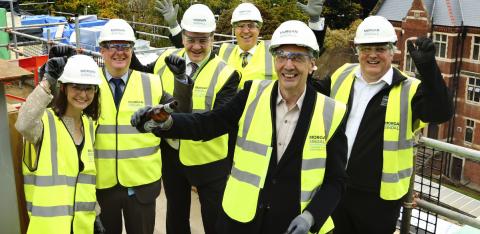Submitted by L. Millard on Thu, 12/11/2015 - 13:02
CSIC’s comprehensive instrumentation of the Department of Engineering’s James Dyson Building has achieved a first.

Image courtesy of Department of Engineering. Tom Dyson, front, leads the topping out ceremony for the new James Dyson Building
At the topping out ceremony for the £13.3 million development, Angus Stephen, Operations Director, Estate Management at the University of Cambridge, said: “The James Dyson Building is one of the first buildings in the world to have so much fibre optic cabling embedded in the infrastructure. We are all fascinated to see the output of this research and applying it to future learning and development across the University.”
Tom Dyson, James Dyson’s brother, led the ceremony - which celebrates the completion of the highest point of the building - by pouring a bottle of Elgoods Cambridge Bitter onto the roof to mark the event.
CSIC has worked alongside contractors Morgan Sindall to integrate a range of novel technologies into the fabric of the building; fibre optic sensors will collect data from the infrastructure enabling researchers to learn more about the structure’s health and behaviour. The instrumentation will act like a ‘nervous system’ for the building.
Distributed fibre optic strain sensors and fibre Bragg sensors have been embedded within a section of the building’s reinforced concrete frame, columns, beams and slabs. The sensors can be interrogated at any time to measure the strain profile within that part of the building, and how the load is being transferred through the different structural elements down to the foundation.
Industry professionals, researchers and students will benefit from this innovative building that offers a ‘living lab’, giving those working inside it a chance to use their surroundings for research and teaching.
The low-carbon building, due to be completed in January 2016, will provide the Department of Engineering with high-quality, flexible research space that enables interdisciplinary working.
“I’m hopeful that this new space for Britain’s best engineers at the University of Cambridge will catalyse great technological breakthroughs that transform how we live.”
- James Dyson
Bob Ensch, Area Director at Morgan Sindall, said: “It’s been a unique project for us and one of the most exciting parts is the innovation we have been involved in helping to install in the building.
“The dialogue with CSIC at the Department of Engineering is exciting because CSIC is doing more than just coming up with new and innovative technologies – it’s asking how we can apply these technologies in the real world and make them economically viable and commercially attractive.
“The information we will get from this instrumentation in the long run is important. The data collected here, measuring the structural health and behaviour of the infrastructure, offers a significant step in reducing the need to over design.”
Professor David Cardwell, Head of the Department of Engineering, explained the significance of the new building, acknowledging the part played by Professor Ann Dowling, former Head of the Department of Engineering and currently President of the Royal Academy of Engineers.
He said: “This is a very exciting time for this department. We have just started embarking on a course that is going to take us to a new level in the provision of academic engineering. This building represents the first step along that very exciting road. This is the beginning – watch this space.”
